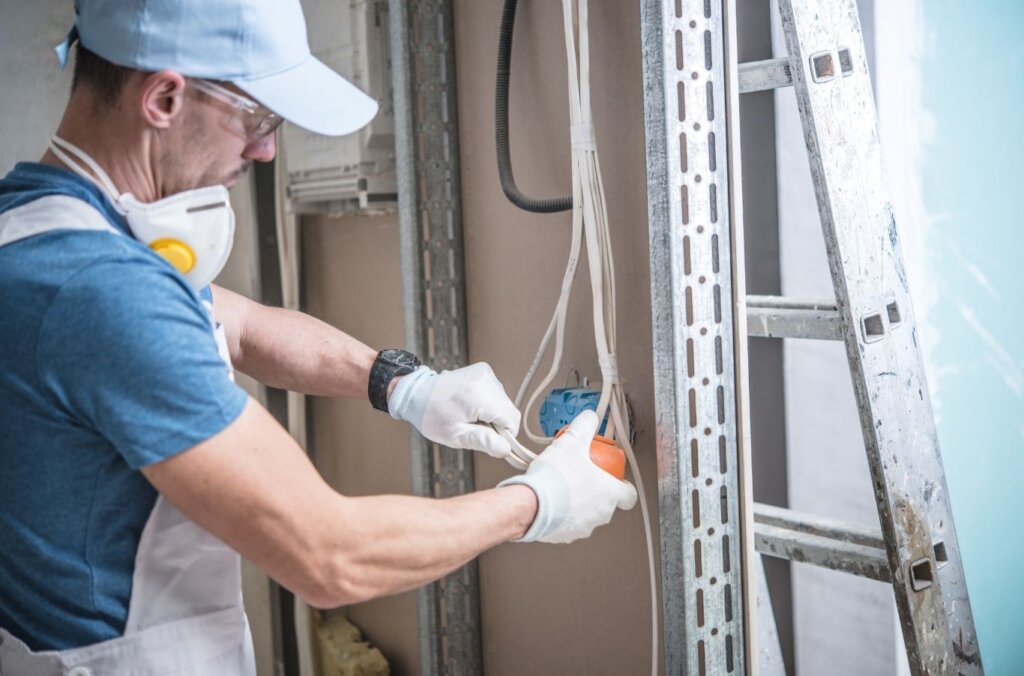As we go about our daily lives, we often take for granted the electricity that powers our homes, offices, and the world around us. But have you ever wondered how electricity reaches us? How does it travel from power plants to our electrical outlets? In this comprehensive guide, I will demystify the electricity grid and provide you with a deeper understanding of modern electrical installations.
The role of an electrician in understanding and maintaining the electricity grid
Electricians play a crucial role in ensuring the safety and reliability of the electricity grid. They are trained professionals who understand the intricacies of electrical systems and are responsible for installing, maintaining, and repairing electrical infrastructure. Without skilled electricians, our electrical systems would be prone to malfunctions, accidents, and even electrical fires.
Electricians have a deep understanding of the electricity grid, including how power is generated, transmitted, and distributed. They are knowledgeable about the different types of electrical equipment and know how to properly install and connect them to ensure efficient and safe operation. Moreover, electricians are trained to identify and troubleshoot electrical problems, making them invaluable in maintaining the reliability of the grid.
What is re-wiring and why is it necessary for a safe and secure electrical installation
Re-wiring is the process of replacing old or faulty electrical wiring in a building with new, updated wiring. It is essential for a safe and secure electrical installation because outdated wiring can pose serious risks such as electrical shocks, short circuits, and even fires. Over time, the insulation on electrical wires deteriorates, making them more prone to damage and exposing occupants to potential hazards.
Re-wiring is necessary to ensure that the electrical system meets modern safety standards and regulations. It involves replacing the old wiring, upgrading electrical panels, and installing new outlets and switches. By doing so, electricians can eliminate potential fire hazards, reduce the risk of electrical accidents, and provide a reliable electrical supply throughout the building.
The process of re-wiring and how it is done
Re-wiring is a complex process that requires careful planning, expertise, and adherence to safety standards. The first step is to assess the existing electrical system to determine the extent of the re-wiring required. This involves inspecting the wiring, panels, and outlets for any signs of damage or outdated components.
Once the assessment is complete, the electrician will create a detailed plan for the re-wiring project. This includes determining the wiring routes, calculating the electrical load requirements, and selecting the appropriate wiring materials. The electrician will then proceed with removing the old wiring, installing new wiring, and connecting the electrical outlets, switches, and fixtures.
Throughout the re-wiring process, the electrician must ensure that all work is performed according to local building codes and safety regulations. This includes proper grounding, insulation, and protection against electrical surges. Once the re-wiring is complete, the electrician will conduct thorough testing to ensure that the electrical system is functioning properly and safely.
Importance of following modern day safety standards during electrical installation
In today’s modern world, safety standards for electrical installations have evolved significantly to protect both occupants and the electrical infrastructure itself. Following these safety standards during electrical installation is of paramount importance to ensure the reliability and safety of the electricity grid.
Modern safety standards cover various aspects of electrical installations, including proper grounding, adequate insulation, and the use of high-quality electrical equipment. These standards are designed to prevent electrical shocks, reduce the risk of electrical fires, and ensure the efficient operation of electrical systems.
Compliance with safety standards also helps to future-proof electrical installations, ensuring that they can accommodate technological advancements and changing electrical needs. By adhering to these standards, electricians can provide their clients with peace of mind, knowing that their electrical system is safe, reliable, and up to date.
Common safety standards and regulations for electrical installations
There are several safety standards and regulations that electricians must follow during electrical installations. These standards are set by regulatory bodies and industry organizations to ensure uniformity and consistency in electrical work. Some of the most common safety standards and regulations include:
- BS 7671:2018 – The British Standard for electrical installations, also known as the IET Wiring Regulations, sets out the requirements for the design, installation, and testing of electrical systems in the UK. It covers everything from electrical supply to the selection and installation of electrical equipment.
- Part P of the Building Regulations – Part P requires that all electrical work in dwellings, including re-wiring, is carried out by competent electricians or certified installers. It aims to prevent electrical accidents and ensure the safety of homeowners.
- Health and Safety at Work Act 1974 – This legislation places a duty of care on employers and employees to ensure the health, safety, and welfare of all persons in the workplace, including electricians and customers. Electricians must adhere to this act to create a safe working environment.
By understanding and following these safety standards and regulations, electricians can ensure the highest level of safety and quality in their electrical installations.
Risks and hazards associated with outdated electrical installations
Outdated electrical installations pose significant risks and hazards that can compromise the safety of occupants and the integrity of the electricity grid. Some of the risks associated with outdated electrical installations include:
- Electrical shocks and burns – Outdated wiring, faulty connections, and inadequate grounding can lead to electrical shocks and burns, which can cause serious injury or even death.
- Electrical fires – Old wiring, overloaded circuits, and outdated electrical panels increase the risk of electrical fires. These fires can spread rapidly and cause extensive damage to properties and endanger lives.
- Power outages and disruptions – Outdated electrical installations are more prone to power outages and disruptions, leading to inconvenience, loss of productivity, and potential damage to electrical appliances and equipment.
- Increased energy consumption – Inefficient electrical systems consume more energy, resulting in higher utility bills and unnecessary strain on the electricity grid.
To mitigate these risks and hazards, it is crucial to hire a professional electrician to assess and upgrade your electrical system.
Hiring a professional electrician for re-wiring and electrical installations
When it comes to re-wiring and electrical installations, it is essential to hire a professional electrician with the necessary expertise and experience. Professional electricians have in-depth knowledge of electrical systems, safety standards, and local regulations. They can provide expert advice, ensure compliance with safety standards, and deliver high-quality workmanship.
When selecting an electrician, consider their qualifications, certifications, and track record. Look for electricians who are registered with a recognized professional body, such as the National Inspection Council for Electrical Installation Contracting (NICEIC). These organizations ensure that their members adhere to strict codes of practice and undergo regular assessments to maintain high standards.
By hiring a professional electrician, you can have peace of mind knowing that your electrical installations are in safe hands and that your electrical system will be reliable, efficient, and compliant with safety standards.
The benefits of upgrading and modernizing your electrical system
Upgrading and modernizing your electrical system offers numerous benefits, both in terms of safety and functionality. Some of the key benefits include:
- Improved safety – Upgrading your electrical system ensures compliance with modern safety standards, reducing the risk of electrical shocks, fires, and other hazards.
- Enhanced reliability – Modern electrical installations are designed to handle the increasing demands of our digital age, providing a reliable and uninterrupted power supply.
- Energy efficiency – Upgraded electrical systems incorporate energy-efficient components and technologies, helping to reduce energy consumption and lower utility bills.
- Increased property value – An upgraded electrical system adds value to your property, making it more attractive to potential buyers or tenants.
- Accommodation of technological advancements – Modern electrical systems are designed to accommodate new technologies, such as smart home automation, electric vehicle charging stations, and renewable energy integration.
By investing in the upgrade and modernization of your electrical system, you can enjoy these benefits while ensuring the long-term safety and functionality of your electrical installations.
Ensuring a safe and reliable electrical grid
Understanding the electricity grid and the role of an electrician is crucial for the safe and reliable functioning of our electrical systems. Through re-wiring and adherence to modern safety standards, we can mitigate the risks and hazards associated with outdated electrical installations.
By hiring a professional electrician, we can ensure that our electrical systems are installed, maintained, and repaired to the highest standards. Upgrading and modernizing our electrical systems not only enhances safety but also offers numerous benefits such as improved reliability, energy efficiency, and increased property value.
Let us prioritize the safety and efficiency of our electrical grid by staying informed, following safety standards, and relying on professional electricians for all our electrical installation needs.





